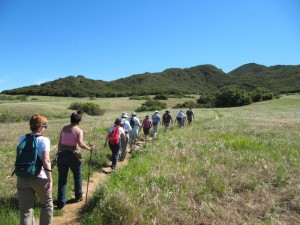Study finds national parks add $47 million to local economy
Source of this article: The Ventura County Star, March 22, 2012
It took just two years for the Weekday Trailblazers hiking group to build its membership roster to nearly 600 people, but the group’s leaders say it isn’t difficult to sell the national parks.
“Once you sit back and realize that these things that I drive past on my way to work every day are easily accessible, people will go to them,” said Simi Valley resident Larry Capps, one of the leaders. “Southern California has everything you want, and it’s all in our national parks. We have deserts, woods, the ocean. You’re just never going to go anywhere where you find anything like you do right here.”
Another group member, Thousand Oaks resident Laurie Deasy, said her favorite part of hiking in the national parks is reaching the top of a mountain after a hard hike and seeing the ocean.
“There’s just a wealth of trails and wealth of beauty,” she said.
Beyond the recreation and natural splendor, a new study paints national parks as economic engines, pumping millions of dollars into surrounding communities.
The study, done by Michigan State University for the National Park Service, surveyed 2010 visitor spending and its effects on communities in a 60-mile radius of each park.
Visitors to Ventura County’s two national parks, the Santa Monica Mountains National Recreation Area and Channel Islands National Park, spent an estimated $47 million in 2010. That spending supported more than 600 jobs, the study estimated.
Woody Smeck, superintendent of the Santa Monica Mountains National Recreation Area, said speaking with park visitors gave him the idea they were spending at local restaurants and businesses. But he was pleasantly surprised to see such a large dollar figure put on it.
Visitors to the Santa Monica Mountains National Recreation Area in 2010 spent an estimated $22.9 million in the park and surrounding communities, according to the report.
“I was really pleased to see a confirmation that the visitors to the parks do produce this level of economic activity and spending,” Smeck said.
A hike and wine tasting are among the popular activities Smeck has heard park visitors discuss.
“There are a lot of wineries in the mountains with tasting rooms, and people have been flocking to these places for wine after a hike,” he said.
In 2010, more than 277,500 visitors spent more than $24 million at Channel Islands National Park and nearby communities, supporting about 300 area jobs, the study estimates.
“It is gratifying to know that one of the many benefits of Channel Islands National Park is to contribute to the local economy and the people and business owners in our community,” Channel Islands Superintendent Russell Galipeau said.
One number reported in the study, the 59,584 “overnight stays” at Channel Islands National Park, seems big when compared with the 144 overnight stays reported for the Santa Monica Mountains National Recreation Area.
Channel Islands spokeswoman Yvonne Menard said the number is accurate, stating that the campgrounds on Santa Cruz Island hold 256 people and are nearly always full. The capacity levels at the Channel Islands’ other campsites are 30 at San Miguel Island, 30 at Anacapa Island, 30 at Santa Barbara Island and 75 at Santa Rosa Island.
Nationwide, the study found local visitor spending added $31 billion to the economy in 2010 and supported more than 258,000 jobs.
Brad Kemp, director of regional research for Beacon Economics in Los Angeles, questioned the national impact calculations.
“National impact is muted,” he said, explaining that a direct effect on the national economy would result only if a U.S. resident planning to travel to a national park went to another country instead. If a U.S. resident vacations at a national park instead of at another domestic location, that traveler would be making a “substitution,” and the nation as a whole would gain no economic value, Kemp said.
Still, Kemp thinks the study is good.
“It’s not realistic to expect that they can do perfection,” he said of the researchers. “It’s very difficult unless you have that intimate level of detail.”



